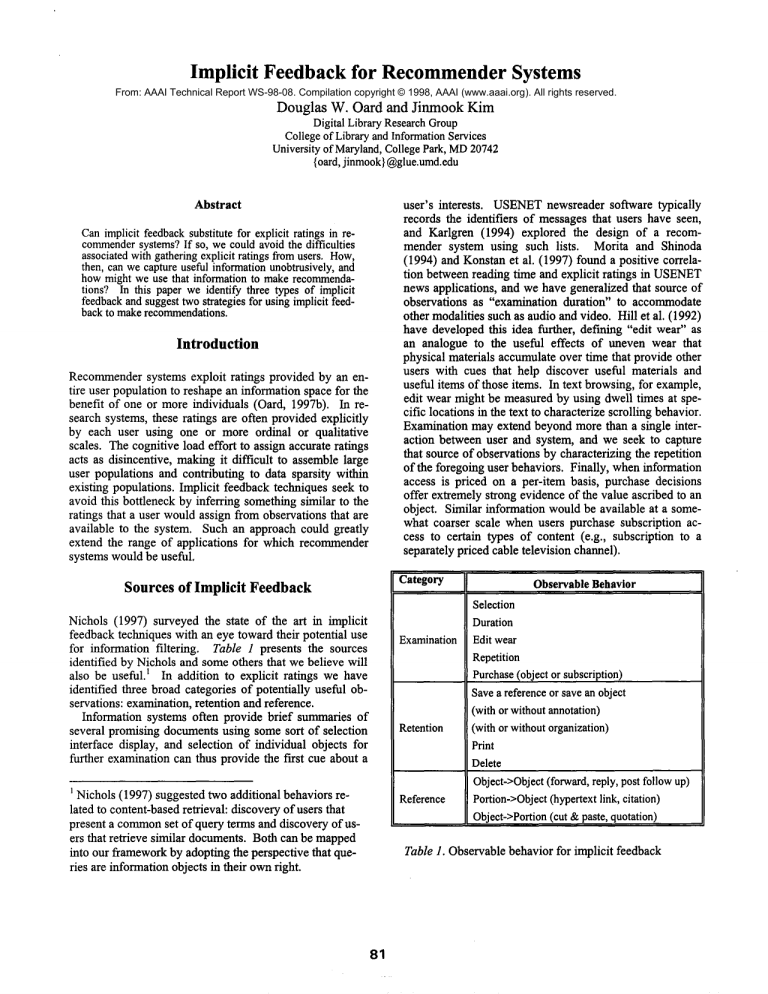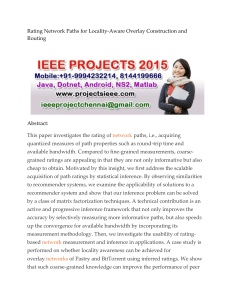
Implicit
Feedback for RecommenderSystems
From: AAAI Technical Report WS-98-08. Compilation copyright © 1998, AAAI (www.aaai.org). All rights reserved.
Douglas W. Oard and Jinmook Kim
Digital Library ResearchGroup
Collegeof Libraryand InformationServices
University of Maryland,CollegePark, MD
20742
{oard, jinmook}@glue.umd.edu
Abstract
Canimplicit feedbacksubstitute for explicit ratings in recommender
systems?If so, wecould avoid the difficulties
associatedwithgatheringexplicit ratings fromusers. How,
then, can wecapture useful informationunobtrusively,and
howmight we use that information to makerecommendations? In this paper we identify three types of implicit
feedbackandsuggesttwostrategies for using implicit feedback to makerecommendations.
Introduction
Recommender
systems exploit ratings provided by an entire user population to reshape an information space for the
benefit of one or more individuals (Oard, 1997b). In research systems, these ratings are often provided explicitly
by each user using one or more ordinal or qualitative
scales. The cognitive load effort to assign accurate ratings
acts as disincentive, makingit difficult to assemble large
user populations and contributing to data sparsity within
existing populations. Implicit feedback techniques seek to
avoid this bottleneck by inferring somethingsimilar to the
ratings that a user wouldassign from observations that are
available to the system. Such an approach could greatly
extend the range of applications for which recommender
systems wouldbe useful.
Sources of Implicit
user’s interests. USENET
newsreader software typically
records the identifiers of messagesthat users have seen,
and Karlgren (1994) explored the design of a recommender system using such lists. Morita and Shinoda
(1994) and Konstanet al. (1997) found a positive correlation between reading time and explicit ratings in USENET
news applications, and we have generalized that source of
observations as "examination duration" to accommodate
other modalities such as audio and video. Hill et al. (1992)
have developed this idea further, defining "edit wear" as
an analogue to the useful effects of uneven wear that
physical materials accumulateover time that provide other
users with cues that help discover useful materials and
useful items of those items. In text browsing, for example,
edit wear might be measuredby using dwell times at specific locations in the text to characterize scrolling behavior.
Examination may extend beyond more than a single interaction between user and system, and we seek to capture
that source of observations by characterizing the repetition
of the foregoing user behaviors. Finally, wheninformation
access is priced on a per-item basis, purchase decisions
offer extremelystrong evidence of the value ascribed to an
object. Similar information wouldbe available at a somewhat coarser scale whenusers purchase subscription access to certain types of content (e.g., subscription to
separately priced cable television channel).
Category [[
Feedback
Nichols (1997) surveyed the state of the art in implicit
feedback techniques with an eye towardtheir potential use
for information filtering. Table 1 presents the sources
identified by Nichols and someothers that we believe will
also be useful, t In addition to explicit ratings we have
identified three broad categories of potentially useful observations: examination,retention and reference.
Information systems often provide brief summaries of
several promising documentsusing somesort of selection
interface display, and selection of individual objects for
further examination can thus provide the first cue about a
l Nichols (1997) suggested two additional behaviors related to content-basedretrieval: discoveryof users that
present a common
set of query terms and discovery of users that retrieve similar documents.Both can be mapped
into our frameworkby adopting the perspective that queries are informationobjects in their ownright.
Observable Behavior
Selection
Duration
Examination Edit wear
Repetition
Purchase(objector subscription)
Savea referenceor savean object
(with or withoutannotation)
Retention
(with or withoutorganization)
Print
Delete
Object->Object
(forward,reply, post followup)
Reference
Portion->Object
(hypertextlink, citation)
Objeet->Portion
(cut &paste, quotation)
Table 1. Observablebehavior for implicit feedback
81
Our "retention" category is intended to group those behaviors that suggest somedegree of intention to makefuture use of an object. Bookmarkinga web page is a simple
exampleof such a behavior, and we have generalized that
idea as "save a reference" to accommodatea wider range
of actions such as construction of symbolic links within a
file system. Rucker & Polanco (1997), for example, constructed a recommender system using bookmark lists.
Saving the object itself is the obvious alternative, something Stevens (1993) used as implicit feedbackfor contentbased filtering. In either case, the object maybe saved
with or without some form of annotation. For example,
webbrowserstypically default to using the page title in the
bookmarklist, but users may optionally provide a more
meaningful entry if they desire. Although numerousconfounding factors wouldlikely be present, it maybe possible to infer somethingabout the value a user places on an
individual page by whether or not they go to the trouble of
constructing an informative bookmarkentry. Similarly,
users may choose to save a reference or an object in an
explicitly organized fashion or in the default manner. For
example, storing electronic mail about this workshopin a
new folder might provide greater support for an inference
that the user ascribes particular value to the messagethan
wouldthe use of somedefault schemesuch as placing it in
the folder routinely used for mail from the message’s
originator. Thesalient issue in this case is not the act of
organizing, but rather the way in which the organization
given to an individual object distinguishes it from the way
in which similar forms of organization are assigned to
other objects. This difference maynot be easy to characterize, but it maybe worth thinking about howto do it. We
have chosento group printing with retention because of the
permanenceof the printed page, but users mayalso print
documentor images to facilitate examination because paper still has somedecided advantages over electronic displays in manyapplications. Printing overlaps with the
next category (reference) as well, since users mayprint
documentor image with the intention of forwarding them
to another individual or including portions in another
document.Nevertheless, printing is often associated with a
desire for retention, so we find this grouping useful. As
with examination, it maybe possible to infer something
about the portions of a documentthat the user finds most
valuable from the portions which he or she chooses to
print. Finally, the retention category is distinguished by
the possibility of directly observing evidence of negative
evaluations as well. Whenretention is a default condition,
as in someelectronic mail systems, a decision by the user
to delete an object might support to an inference that the
deleted object is less valued than other objects that are
retained.
The "refer to" category mayappear at first glance to
contain a fairly eclectic group of observableactivities, but
each has the effect of establishing someform of link between two objects. Forwarding a message, for example,
establishes a link betweenthe new messageand the original. Similarly, replying individually or posting a follow up
message to some form of group venue such as a mailing
list establishes the same sort of link. Goldberg et al.
(1987) described a simple exampleof this in which users
could construct an electronic mail filter to display messages that their colleagues had taken the time to reply to.
Hypertext links from one web page to another and bibliographic citations in academicpapers create links from a
portion of an object (characterized, perhaps, by some
neighborhoodaroundthe link itself) to another object, although the refinement to a portion of a documenthas not
been exploited often. Brin & Page (1998) provide an exampleof howhypertext links might be used, although their
focus is on a population statistics rather than individual
preferences. Garfield (1979) describes the design of retrieval systems that are based on bibliographic citations.
Alternatively, selective inclusion of another document,
using either cut-and-paste or a quotation, creates a link
from an informationobject to a portion of another.
Using Implicit Feedback
The goal of a recommendersystem is to help users fred
desirable information objects. That task combinesinference and prediction, and Figures 1 and 2 showalternative
strategies for accomplishing this. Figure 1 depicts a
modularstrategy in which the inference stage seeks to produce ratings similar to those that a user wouldhave explicitly assigned, and then the prediction stage uses those
estimated ratings to predict future ratings. Konstanet al.
adopted this perspective when evaluating how well observed reading time predicted explicit ratings for individual articles. Figure 2 shows an alternative strategy in
which past observations are used to predict user behavior
in response to new information, and then the inference
stage seeks to estimate the value of the information based
on the predicted behavior. Weare not aware of any implementations of this second approach, but Stevens (1993)
implementeda simplified version of the strategy. He predicted the examination duration for a new USENET
news
article based on the examinationdurations for similar articles in the past and then constructed content-based queries
that wouldselect articles with long predicted examination
durations. This essentially amountsto a degenerate inference stage in which desirability is assumed to increase
monotonically with examination duration.
Thedistinction betweenthe twostrategies is quite subtle
in the case of content-based filtering. In a recommender
system, by contrast, the strategy shownin Figure 1 would
characterize each article using the examination durations
reported by other users, while the strategy shownin Figure
2 wouldcharacterize each article using the predicted ratings for other users. Recommender
systems based on the
secondstrategy might be moreflexible, since participating
users might draw different inferences from the same observations if they did not share a common
set of objectives.
On the other hand, recommendersystems using the first
strategy wouldlikely have more context available locally
for interpreting observations than wouldbe available at
82
other points in the network. It might thus be worth considering hybrid approaches in which somepreliminary interpretation is performedlocally whenthe observaton is made
and then additional inferences are drawnat other points in
the network.
cantly expand impact and importance of recommender
systems in a networkedworld.
References
Brin, S. and Page, L. 1998. The Anatomyof a Large-Scale
Hypertextual WebSearch Engine. Dept. of ComputerScience, Stanford Univ.
http_ ://google.stanford.edu/~backrub/google.html.
Observations
Inference
I
Goldberg,D., Nichols, D., Oki, B. M, and Terry, D. 1992.
Using Collaborative Filtering to Weavean Information
Tapestry. Communicationof the ACM,December,35 (12 ):
61-70.
Estimated ratings
Prediction
I
Predicted ratings
Garfield, E. 1979. Citation Indexing: Its Theoryand Application in Science, Technology, and Humanities. New
York: Wiley-Interscience.
Figure 1. Rating estimation strategy.
Hill, W.C., Hollan, J. D., Wrobelwski,D. and McCandless,
T. 1992. Read Wearand Edit Wear. In: Proceedings of
ACMConference on HumanFactors in Computing Systems, CHI’92: 3-9.
Observations
Prediction
I
Karlgren, J. 1994. NewsgroupClustering Based on User
Behavior: A RecommendationAlgebra. Technical and
Research Reports from SICS, T94-01.
http_ ://www.~ic s. se/libabstracts.html#T94/04.
Predicted observations
Inference
I
Konstan,J. A., Miller, B. N., Maltz, D., Herlocker,J. L.,
Gordon, L. R., and Riedl, J. 1997. GroupLens:Applying
Collaborative Filtering to Usenet News. Communications
of the ACM,March, 40(3): 77-87.
Predicted ratings
Figure 2. Predicted observations strategy.
Morita, M. and Shinoda, Y. 1994. Information Filtering
Based on User Behavior Analysis and Best Match Text
Retrieval. In Proceedingsof the SeventeenthAnnualInternational ACM-SIGIR
Conference on Research and Developmentin Information Retrieval, 272-281.
Conclusion
Wehave presented three potential sources for implicit
feedback and described two ways those sources could be
used by recommendersystems. Our "examination" category seeks to capture ephemeralinteractions that begin and
end during a single session, while the "retention" category
groups user behaviors that suggest an intention for future
use of the material. Our third category is reference, which
includes user behaviorsthat create explicit or explicit links
between information objects. Webelieve these categories
group observable behavior in a way that is useful when
thinking about how to make predictions, and toward that
end we have suggested two strategies for using implicit
feedback in recommendersystems. Our present work is
focused on understanding howto relate observations to
predicted ratings, both individually and in various combinations that could be more informative than single-source
observations. Wethen hope to develop and implement a
prototype that will give us someinsight into howimplicit
feedback can be used effectively in an application environment. If successful, this approach could help transcend
the current reliance on explicit ratings and thus signifi-
Nichols, D. M. 1997. Implicit Ratings and Riltering. In
Proceedings of the 5th DELOS
Workshopon Filtering and
Collaborative Filtering, 10-12. Budapaest, Hungary,
ERCIM.
Oard, D. W.1997. The State of the Art in Text Filtering.
User Modelingand User-AdaptedInteraction, 7(3): 141178. http;//www.glue.umd.edu/-oard/research.html.
Rucker, J. and Polanco, M. J. 1997. Personalized Navigation for the Web. Communicationsof the ACM,March,
40(3): 73-89.
Stevens, C. 1993. Knowledge-BasedAssistance for Accessing Large, Poorly Structured Information Spaces.
Ph.D. dissertation, Dept. of ComputerScience, Univ. of
Colorado, Boulder.
http;//www.holodeck.com/curt/m_vp,
apers.html.
83






